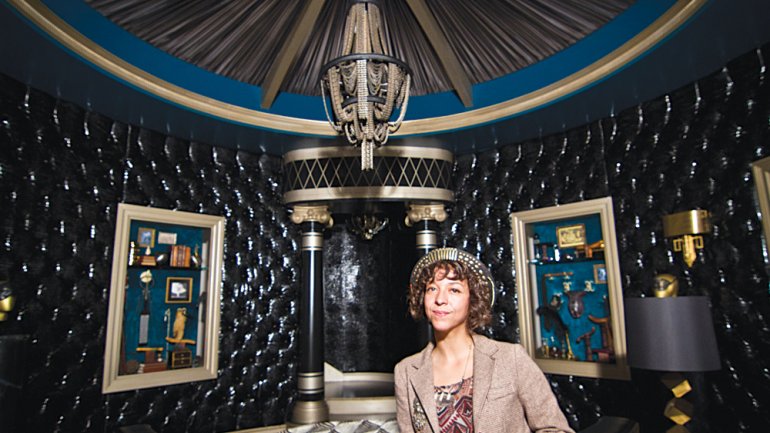Facaro
Facaro
The imposing chandeliers hang in cascading splendor in Neil Patrick Harris’ New York townhouse and in a watch boutique in LA’s tony Sunset Plaza, where wares can sell for $200,000 a pop. They look equally at home in the True Blood horror TV series.
What links them? The fixtures, though traditional in form, are made of old bicycle chains that artist Carolina Fontoura Alzaga scrounges from bike shops around Los Angeles. “I think the element of surprise is one of the things that makes them so alluring,” says Alzaga, who goes by Facaro in her work life. As people get closer, it starts to dawn on them: They’re not seeing crystal, or even glass, prompting “a kind of cognitive dissonance with this base material in elegant form,” she says.
She didn’t expect to become the “it” designer for the luxe set when she made her first bike-part sculpture in 2007 as her art school thesis project. Though she had majored in painting and digital design, she was steeped in the DIY bikepunk culture, so it wasn’t a big leap; and coming from that world, her lack of fabrication skills didn’t faze her. She dove in and hasn’t looked back.
She’s had an enviably quick rise, selling her first piece when she was living in Mexico City in 2009, thanks to the support of gallery owner Arturo Mizrahi; since 2010, business has doubled every year but one.
It hasn’t always been a smooth ride, though. “Growth reached a point where I no longer could do it on my own,” she says. So in 2014 she took a few months off to reorganize the business. She now has a fulltime studio assistant, as well as a part-time engineer who builds her armatures and shares her new workspace in a former car factory in South Central Los Angeles.
Her DIY roots have served her well; she lived frugally the first few years. “I traveled, had no lease. I could let this project develop organically, because my survival didn’t depend on it,” she says. “I’m very fortunate that people took a liking to my work.”
That work requires a tremendous amount of labor and time – sometimes the smallest adjustment can take an hour – so many of her clients are businesses or institutions.“I get a lot of designers and architects, looking for lighting for restaurants and lobbies and hotels.”
But, like the viewer who realizes that brilliant chandelier is made of scrap metal, Alzaga has a little case of cognitive dissonance herself – her work is out of reach of most of her artist colleagues and friends. (“I can’t even afford my own work,” she jokes.) She will occasionally barter with people who love the chandeliers but can’t necessarily afford them.
And though she likes hanging out at some of the posh venues that buy her works, she still makes her rounds at the bike shops and junkyards. “It’s important,” she says. “It keeps you grounded.”
The Bottom Line
Time it takes to make a chandelier: Two to 10 weeks.
Dimensions (standard models): 12 – 60 in. high, 12.5 – 25.5 in. dia.
Countries where her work hangs: Bahrain, Canada, China, France, Japan, Mexico, Poland, Netherlands, Norway, Switzerland, UK, US.
First big break: Solo exhibition, 2009, Fifty24MX Gallery, Mexico City.
Second big break: When Croft House owner-designer Riley Rea offered her free workspace for three years. “Without that generosity, I would not have been able to develop my work and business – period. Period.”
What’s next: Finding retailers in New York, Los Angeles (other than Croft House), and San Francisco to carry her work. “The next step is Europe, and the next step after that is Asia.”
Judy Arginteanu is a writer and editor in Minneapolis, and American Craft's copy editor.




